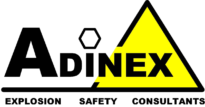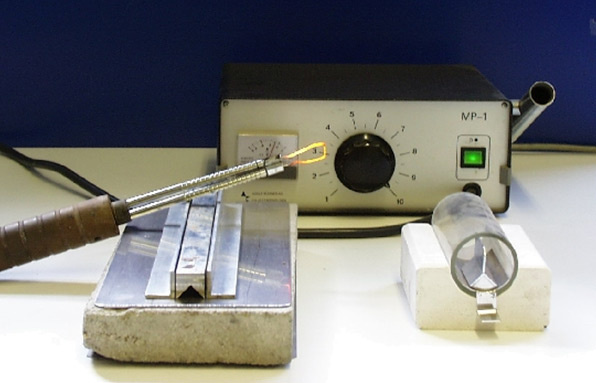The combustion class of a substance (Ciba-Geigy method) gives an indication of the ignitability and combustibility of a dust layer when a platinum wire at a temperature of approx. 1000°C is brought into contact with the layer.
Combustibility
The test material is poured onto a fire-resistant plate to form an unbroken strip of product approx. 40 mm long and approx. 20 mm wide (volume approx. 5 ml). An electrically heated, glowing platinum wire at a temperature of approx. 1000°C is dipped into the test substance at one end of the product strip for approx. 5 seconds.
The behaviour during combustion is rated in accordance with the course of reaction. The rating of the combustion is classified as follows:
| Determination of combustion class | |||
|---|---|---|---|
| Test result | CL | Reference product | |
| no ignition | no spreading of fire | 1 | table salt |
| brief ignition and rapid extinction | 2 | tartaric acid | |
| localised combustion or glowing with practically no spreading | 3 | d+ lactose | |
| glowing without sparks (smouldering) or slow decomposition without flame | fire spreads | 4 | 1-amino-8-naphthol-3,6-disulfonic-acid |
| burning like fireworks or slow quite burning with flames | 5 | sulphur | |
| very rapid combustion with flame propagation or rapid decomposition without flame | 6 | black powder | |
The tests are carried out in a ventilated laboratory hood. The air velocity at the test location is approximately 0.2 m/s (in the same direction as the propagating reaction). The superimposed light air stream is necessary to vent the inert gases which are generated upon ignition of the product and which may inhibit the combustion behaviour of the dust.
If the combustibility of a product is of interest at elevated temperature (e.g., if drying is contemplated), the combustibility test can be repeated at elevated temperature (e.g., at the anticipated drying temperature). This is not necessary if the test already resulted in a class 6 at room temperature. Sometimes there is a marked difference in the combustion behaviour. Therefore, the test temperature has to be listed together with the combustion class.
Additional working aids are needed for this test: a mould for the sample, a sample holder, a glass tube and an insulating support. These working aids can also be used to carry out the combustibility test at room temperature.
The test is performed on the sample fraction having a particle size less than 250 µm.
- VDI-Richtlinien 2263, Blatt 1: Untersuchungsmethoden zur Ermittlung von sicherheitstechnischen Kenngrössen von Stäuben (1990)
- EN 17077:2018: Determination of burning behaviour of dust layers
- Kühner AG, Safety testing equipment: Screening tests – Test procedures
- W. Bartknecht, Staub Explosionen: Ablauf und Schutzmassnahmen (1987)
- R.K. Eckhoff, Dust explosions in the process industries (1997)
- Explosion protection manual, Kluwer-Editorial

